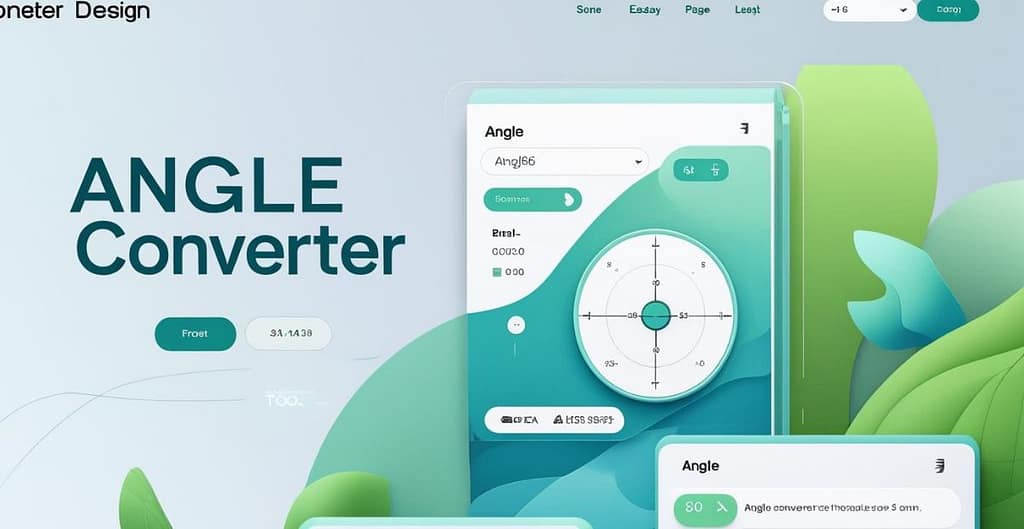Angle Conversion Calculator
Convert between degrees, radians, gradians, arcminutes, and arcseconds with our accurate angle conversion tool
Angle Unit Converter
Understanding Angle Measurement: A Comprehensive Guide
Angle measurement is a fundamental concept in mathematics, physics, engineering, and many other fields. Different measurement systems have developed over time to serve various purposes, from navigation to advanced mathematics. Understanding how to convert between these units is essential for students, professionals, and anyone working with angles.
What is an Angle?
An angle is formed by two rays (the sides of the angle) sharing a common endpoint (the vertex). Angles are used to measure the amount of turn or rotation between these two rays. The concept of angles is fundamental to geometry, trigonometry, and many practical applications in science and engineering.
Common Angle Units and Their Definitions
Degree (°)
The most common unit of angle measurement, where a full circle is divided into 360 degrees. This system dates back to ancient Babylonian astronomy.
Radian (rad)
The SI unit for angle measurement, defined as the angle subtended at the center of a circle by an arc equal in length to the radius of the circle.
Gradian (grad)
Also known as gon, where a right angle is 100 gradians and a full circle is 400 gradians. Commonly used in surveying and some engineering fields.
Arcminute (‘)
Equal to 1/60 of a degree, used in astronomy, navigation, and cartography for precise measurements of small angles.
Arcsecond (“)
Equal to 1/60 of an arcminute or 1/3600 of a degree. Used for extremely precise measurements in astronomy and geolocation.
Practical Applications of Angle Conversion
Mathematics Education
Students frequently need to convert between degrees and radians when studying trigonometry and calculus.
Engineering
Engineers work with different angle units depending on their specialization and the standards used in their field.
Navigation
Maritime and aviation navigation use degrees, but sometimes require conversion to other units for specific calculations.
Astronomy
Astronomers use arcminutes and arcseconds to measure the apparent sizes of celestial objects and their separations.
Surveying
Land surveyors often use gradians for their measurements, requiring conversion to other units for documentation.
Computer Graphics
Game developers and graphic designers need to convert between angle units for different rendering engines and mathematical functions.
How to Use Our Angle Conversion Tool
Our angle converter simplifies the process of converting between different angle measurement units:
- Enter the numerical value you want to convert
- Select the unit you’re converting from
- Select the unit you want to convert to
- Click the “Convert Angle Units” button
- View your converted value instantly
The tool handles all the complex calculations behind the scenes, ensuring accurate results every time. Whether you need to convert degrees to radians for a trigonometry problem or arcminutes to degrees for astronomical calculations, our converter provides precise results instantly.
Mathematical Relationships Between Angle Units
Understanding the mathematical relationships between different angle units can be helpful:
- 360 degrees = 2π radians ≈ 6.2832 radians
- 360 degrees = 400 gradians
- 1 degree = 60 arcminutes
- 1 arcminute = 60 arcseconds
- 1 radian ≈ 57.2958 degrees
- 1 gradian = 0.9 degrees
Frequently Asked Questions About Angle Conversion
The division of a circle into 360 degrees dates back to ancient Babylonian astronomy. The Babylonians used a base-60 number system (sexagesimal), and 360 was a convenient number as it has many divisors. This system was later adopted by the Greeks and has persisted to modern times.
Radians are generally preferred in higher mathematics, physics, and engineering contexts because they often simplify calculations, particularly in calculus and trigonometry. Many mathematical functions in programming languages also use radians by default. Degrees are more common in everyday applications, navigation, and elementary mathematics.
Gradians (also called gons) are primarily used in surveying, civil engineering, and some military applications. The gradian system divides the right angle into 100 units, which can make calculations easier in certain surveying applications. However, they are less common than degrees or radians in most other fields.
Our converter uses precise mathematical relationships and conversion factors to ensure high accuracy. The calculations are based on standard mathematical constants (like π) with sufficient precision for educational, professional, and scientific purposes. For extremely precise scientific calculations, additional significant figures might be needed.
Astronomers use arcminutes and arcseconds because celestial objects often appear very small in the sky, and these units allow for precise measurement of their apparent sizes and separations. For example, the full moon has an apparent diameter of about 30 arcminutes, while the resolution of the Hubble Space Telescope is about 0.05 arcseconds.

Use our more free tools at earnapki.com
Energy Converter tool
Power Converter
Pressure Converter tool
Number to Roman Numerals
QR Code generator